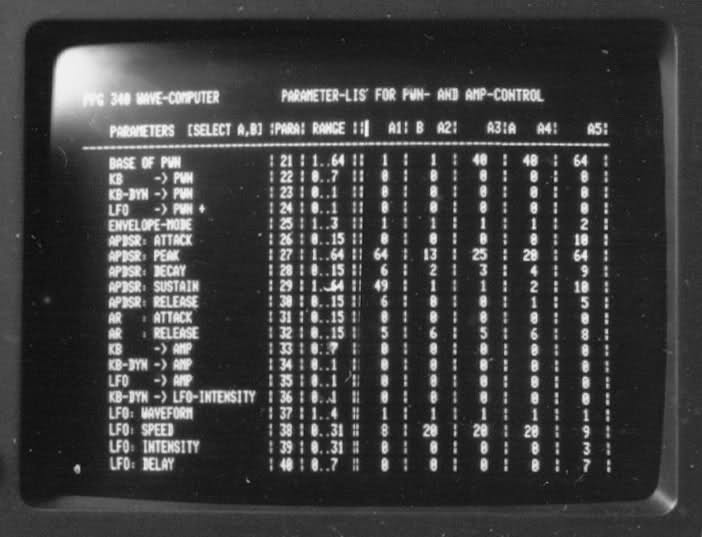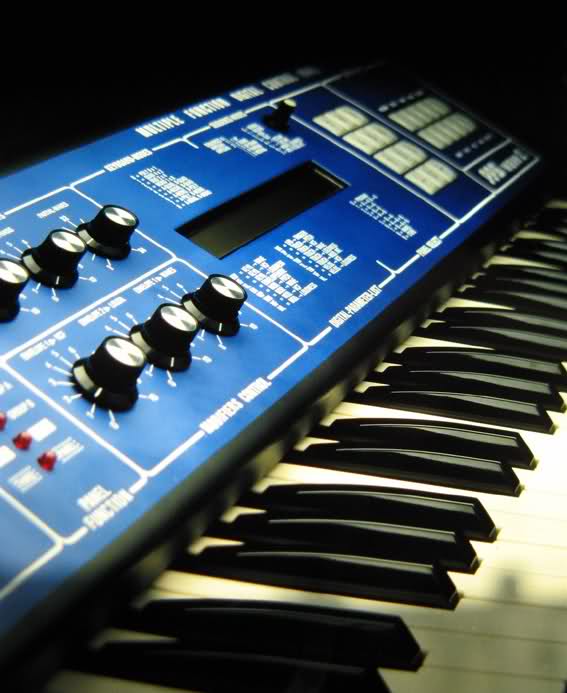The PPG Story
Up to this point, development was always done on a microprocessor system based on the first 8-bit Motorola µP. For that, I had built special boards that were put into a 19" rack. In the meantime, we also had a real computer monitor instead of the TV set that could display 80 characters in 25 lines, and thereby made programming much easier.
Now Armin Stöwe, Ingo Werner and Reinhard Karwatky, came into play again. They had very precise ideas about a clock/sequencer. It was about being able to produce triplets, quatruplets, quintuplets, and so on, up to 1/16 (including 1/15 1/14 etc.), as precise as possible. Normally, this would have needed a gigantic heap of hardware. Finally, I could convince them to do it with my computer system instead, particularly since you could control all timbre changes with the sequencer as well.
So, the sound synthesis unit was expanded with a sequencer unit (with its own microprocessor). Now, the system consisted of three 19" units, a monitor, and a keyboard. For the time, it was a gigantic programming work, and, beside Wolfgang Kowalk, I was now mainly doing programming.
 The PPG 360 was also completed, and Wolfgang Düren sold some - mainly in Germany. He had good contacts with Edgar Froese, and had sold him a 340/380 system. When orders diminished, and he got the offer from Edgar to go on tour with him (as personal assistant, and to service the PPGs), he did not need a second invitiation.
The PPG 360 was also completed, and Wolfgang Düren sold some - mainly in Germany. He had good contacts with Edgar Froese, and had sold him a 340/380 system. When orders diminished, and he got the offer from Edgar to go on tour with him (as personal assistant, and to service the PPGs), he did not need a second invitiation.
One of my most faithful customers was Chris Evans Ironside, who produced the "Stonehenge" album with his 360, in which the pure wave sounds shone out really well.
In the meantime, the "Fairlight CMI" had appeared on the scene and caused quite a sensation. We could not do much against it with our 340/380 system - all people wanted to use sampling now!
Since we were under pressure from Oberheim and Sequential Circuits on one side, and from Fairlight on the other, and since Wolfgang Düren heard again and again from customers that there was no filter in the Wave, we decided to build a successor to the Wavecomputer 360, that, in addition to wavetable synthesis, contained analog filters. ("best of both worlds", as our English distributor put it later in an ad)
By now, Motorola had a new processor, the 6809, which had considerably more computing power than the old 6800. So I decided to switch to it. Another problem of the 360 was the complicated operation with the LED displays. So, the new synth received an LCD display. At the '81 fair, the prototype was introduced, it was the "Wave 2". We already had some retailers worldwide, and the Wave 2 was received very favorably! Even Fairlight developer Peter Vogel visited us at the booth and said: "The Wave 2 is the highlight of the fair, just after the Fairlight." And that really was the case. Now Oberheim and SC had to think something up.
However, it took some more years until SC also brought out a synth with wavetables.
Die Basis für die bisherige Entwicklung war immer ein Mikroprozessor-System, basierend auf dem ersten 8-bit MP von Motorola. Ich hatte dazu eigene Platinen entworfen, die in ein 19"-Rack eingebaut waren. Inzwischen gab es auch einen richtigen Computer-Monitor anstelle des Fernsehers, der 80 Character und 25 Zeilen darstellen konnte und somit das Programmieren erheblich erleichterte.
Nun kam wieder Armin Stöwe, Ingo Werner und Reinhard Karwatky ins Spiel. Sie hatten eine sehr genaue Vorstellung von einem Taktgeber/Sequenzer. Es ging darum, Triolen, Quatolen, Quintolen etc. bis hinauf zu 1/16, (also auch 1/15 1/14 etc.) so genau wie möglich produzieren zu können. Das wäre normalerweise nur mit einem riesigen Hardwareaufwand möglich gewesen. Ich konnte sie schließlich dazu überreden, das Ganze lieber mit meinem Computersystem zu machen, zumal man dann auch noch alle Klangfarbenänderungen mit dem Sequenzer steuern konnte. So wurde also die Klang-Synthese-Unit durch die Sequenzer-Unit (mit eigenem Micro-Prozessor) erweitert.
Das System bestand nun aus drei 19' Einheiten und einem Monitor mit Tastatur.
Es war für die damalige Zeit ein Riesen Programmieraufwand, und ich war, neben Wolfgang Kowalk, nun überwiegend mit dem Programmieren beschäftigt.
Der PPG 360 war auch fertig entwickelt, und Wolfgang Düren verkaufte einige - hauptsächlich in Deutschland. Er hatte gute Kontakte zu Edgar Froese, und hatte ihm ein 340/380 system verkauft.
Als es dann mit den Bestellungen weniger wurde und er das Angebot von Edgar bekam, mit ihm auf Tour zu gehen (als personal assistent, und um die PPG's zu betreuen) hat er sich das nicht zweimal sagen lassen.
Einer meiner treuesten Kunden war Chris Evans Ironside, der mit seinem 360'er das "Stonehenge" Album produzierte, in dem die puren wave sounds sehr schön zum Tragen kommen.
Inzwischen war das "Fairlight CMI" auf der Bildfläche erschienen, was für riesige Furore sorgte. Wir konnten mit unserem 340/380-System wenig dagegen ausrichten - die Leute wollten nun alle samplen!
Da wir auf der einen Seite von Oberheim und Sequencial Circuits Druck bekamen, auf der anderen Seite von Fairlight, und da Wolfgang Düren immer wieder von den Kunden zu hören bekam, dass ja im Wave kein Filter sei, haben wir beschlossen einen Nachfolger für den 360 Wavecomputer zu bauen, der zusätzlich zu der Wavetablesynthese auch noch analoge Filter hat. ("best of both worlds", hieß es später in der Anzeige unseres englischen Vertriebes)
Jetzt gab es einen neuen Prozessor von Motorola, den 6809, der wesentlich mehr Rechenpower hatte als der alte 6800. Also beschloss ich auf diesen umzusteigen. Ein anderes Manko des 360, war die komplizierte Bedienung, mit den LED Anzeigen. Also bekam der neue Synth ein LCD Display verpasst. Zur 81'er Messe wurde der Prototyp vorgestellt, es war der "Wave 2". Wir hatten nun schon einige Händler weltweit, und der Wave 2 kam durchweg gut an! Sogar der Fairlight-Entwickler Peter Vogel kam bei uns auf den Stand und sagte: "der Wave 2 ist das Highlight der Messe, gleich nach dem Fairlight". Und so war es auch tatsächlich. Nun mussten Oberheim und SC sich etwas einfallen lassen.
Es dauerte jedoch noch einige Jahre, bis SC auch einen Synth mit Wavetables herausbrachte.
